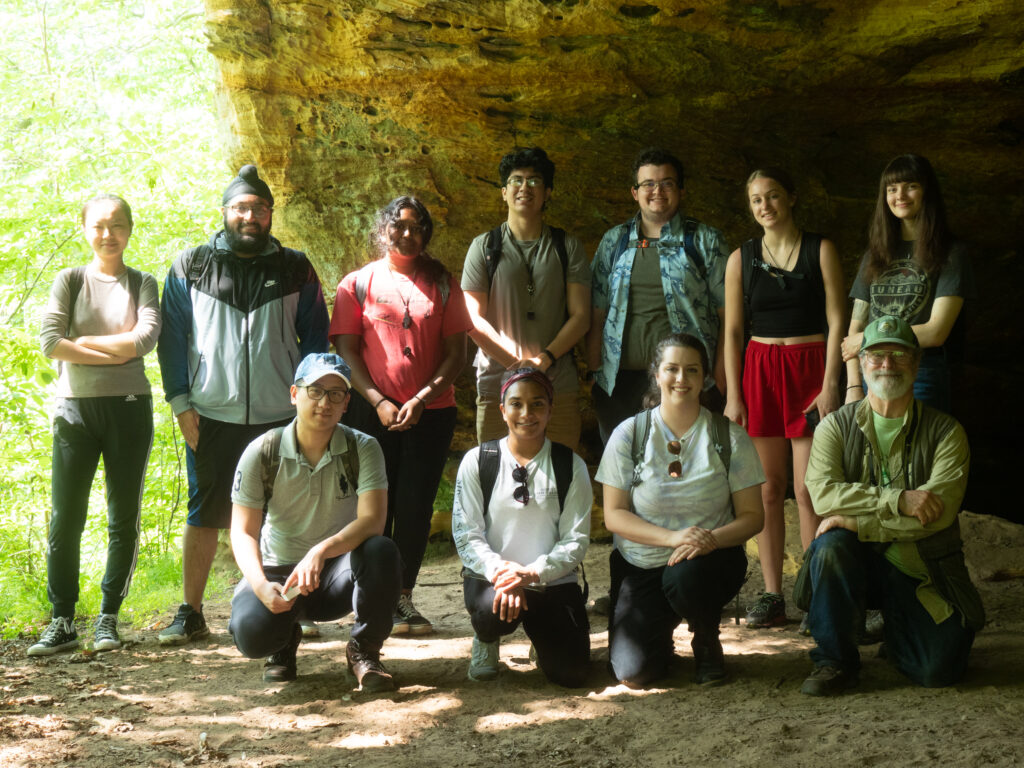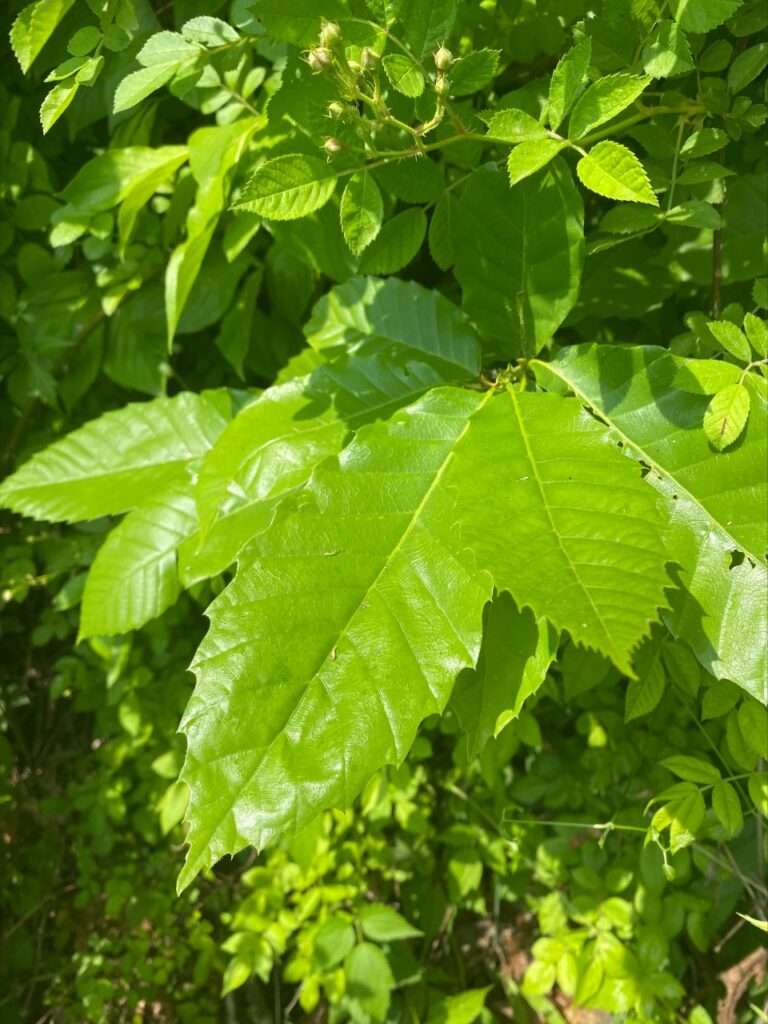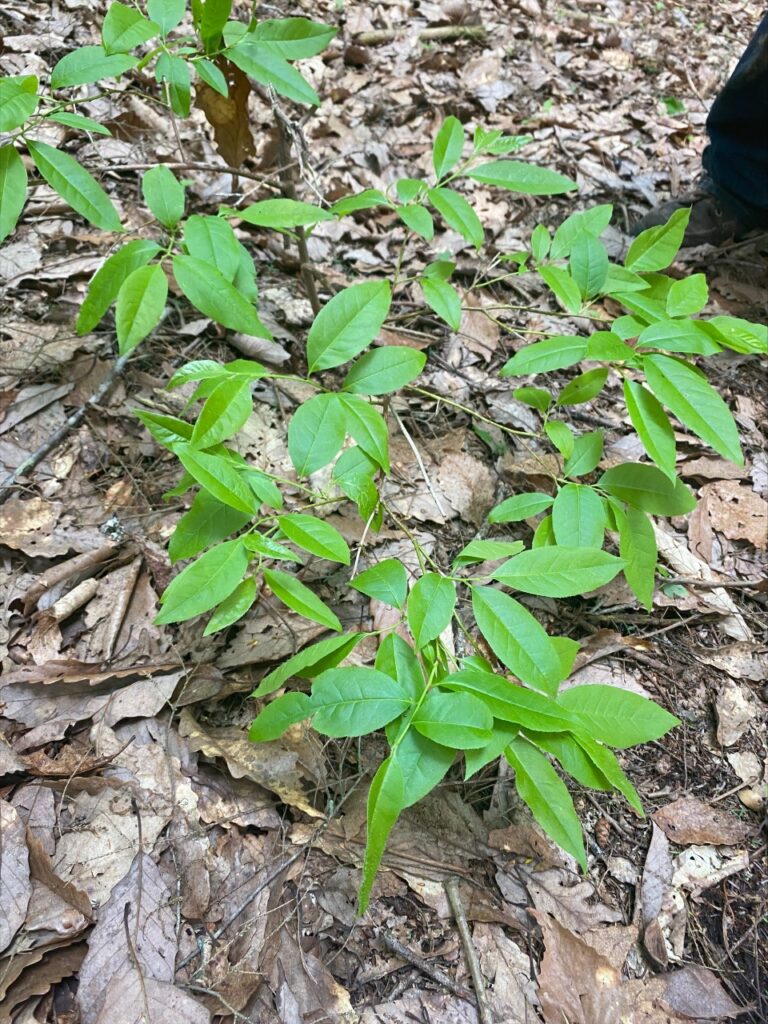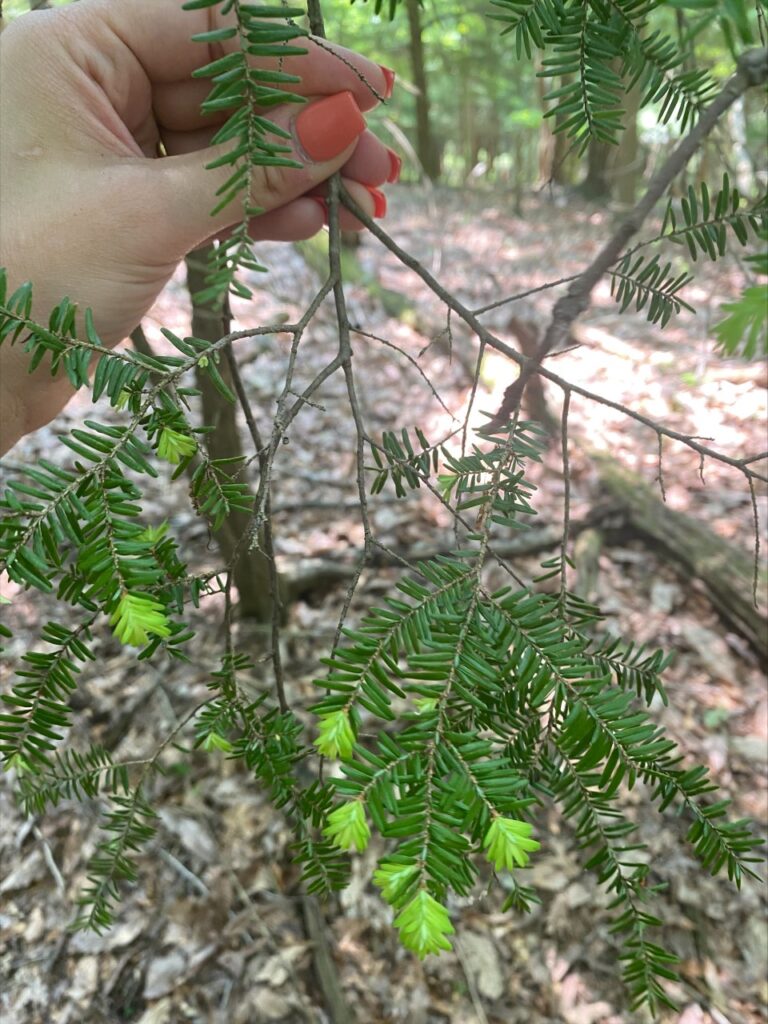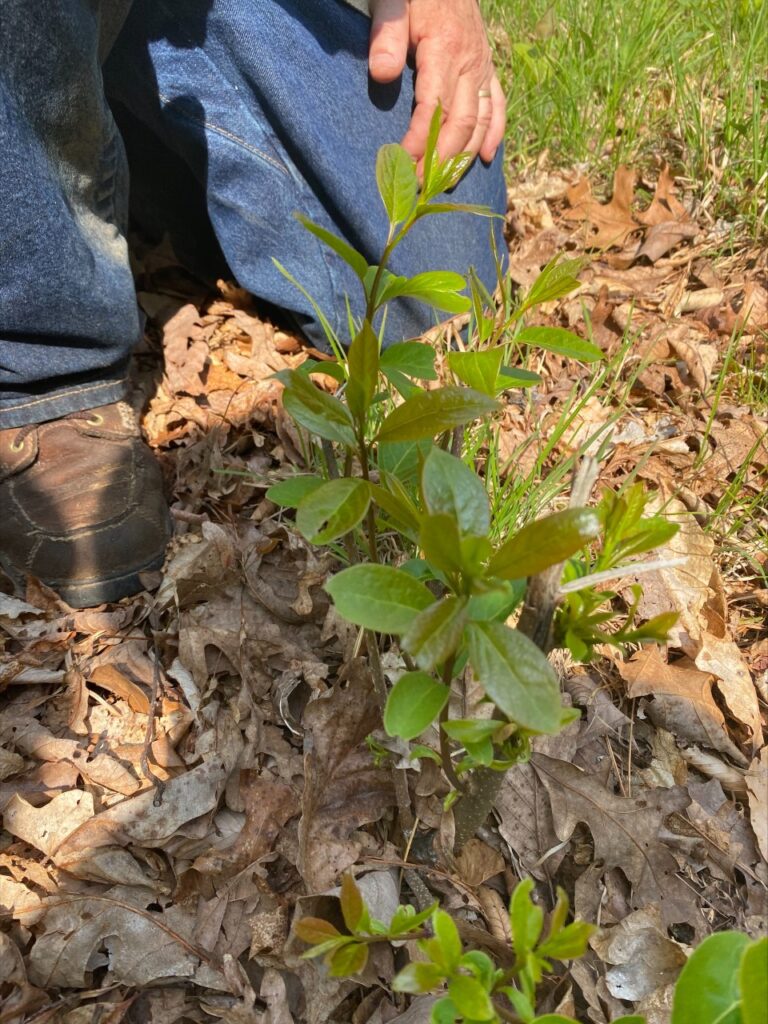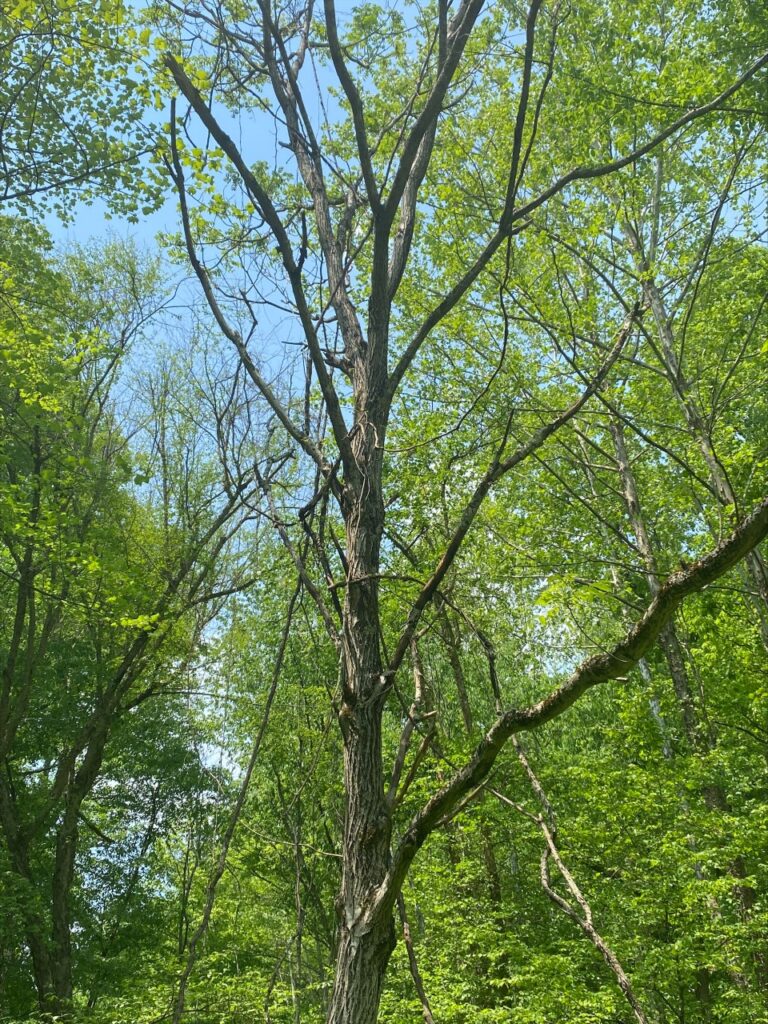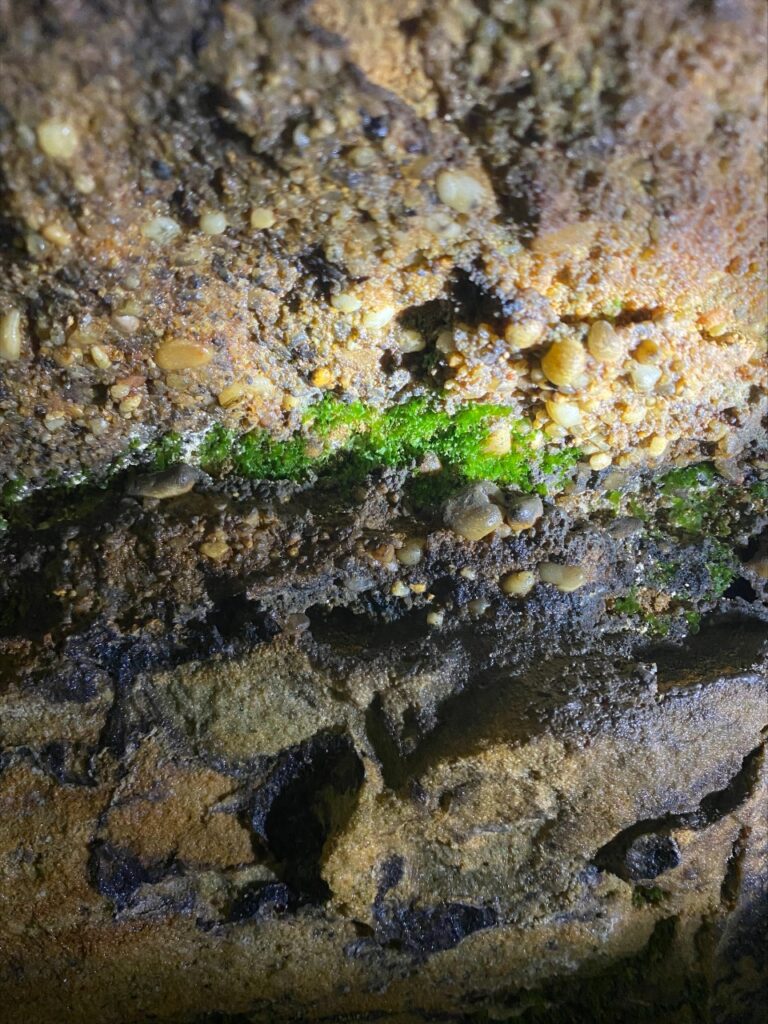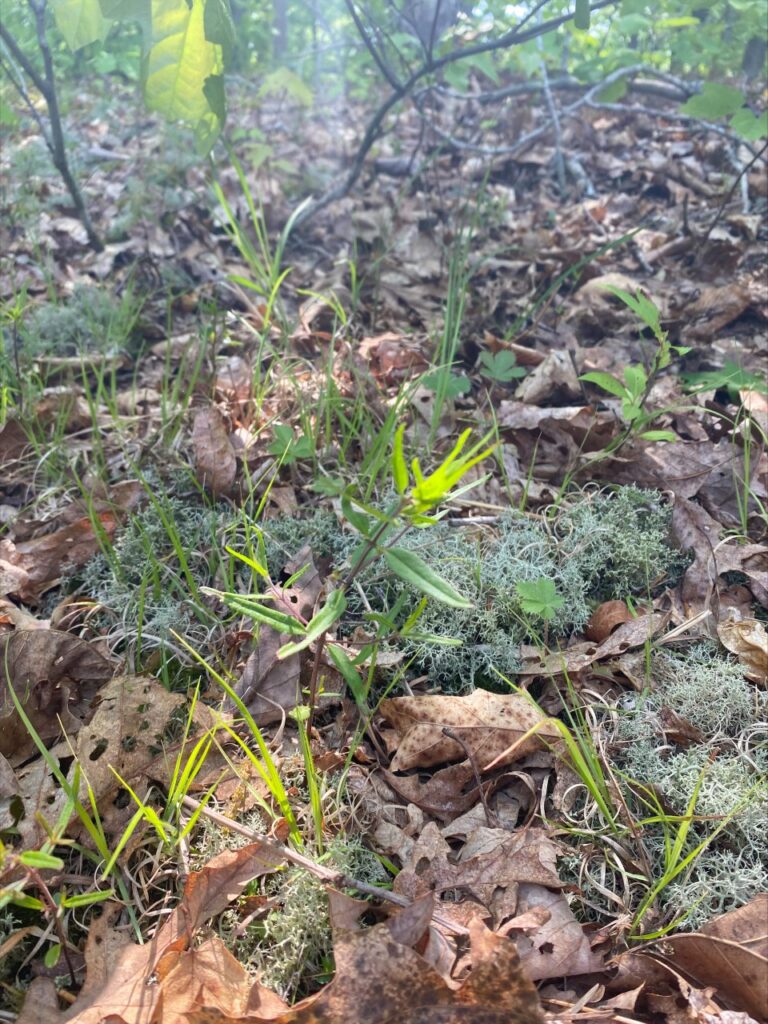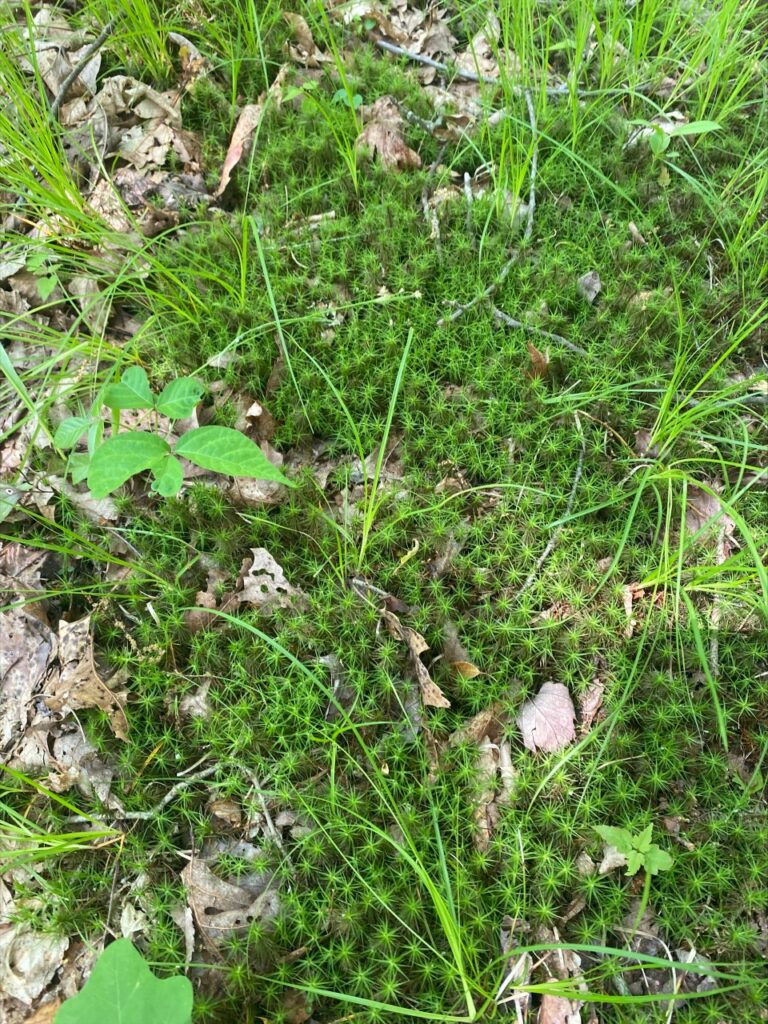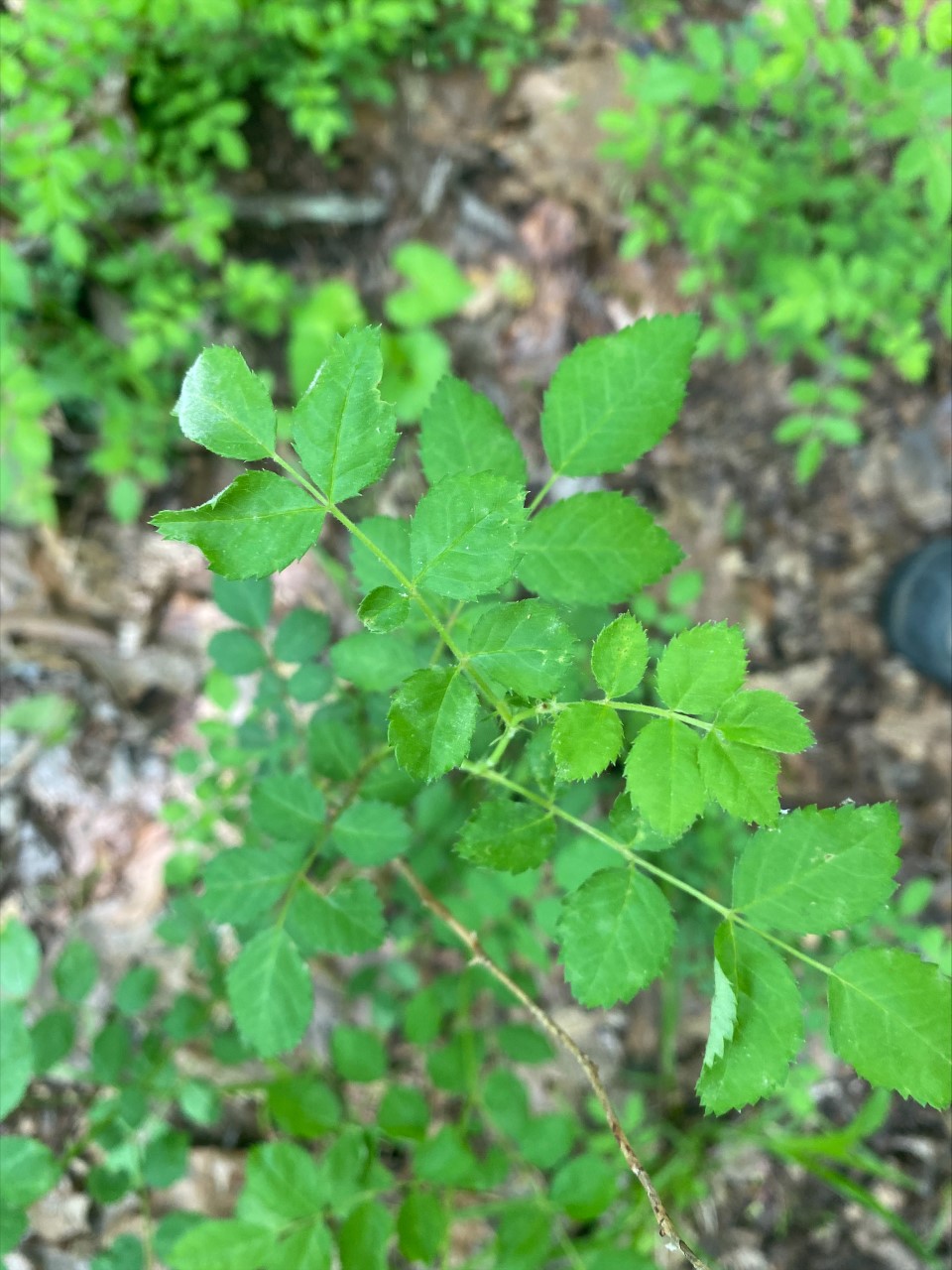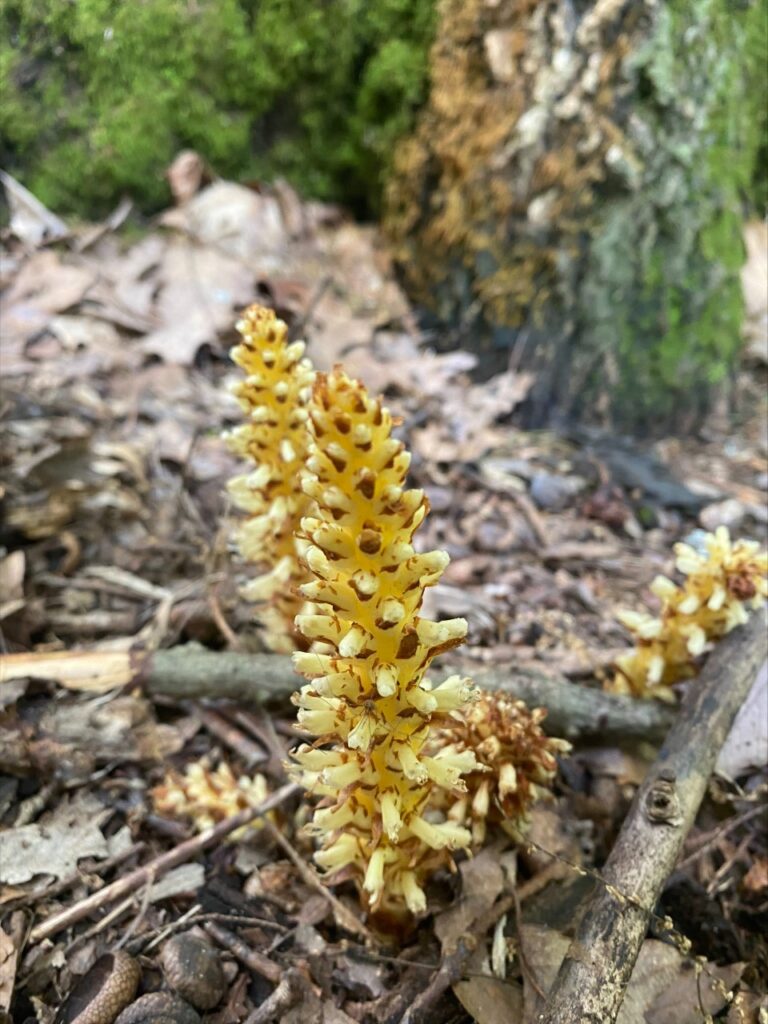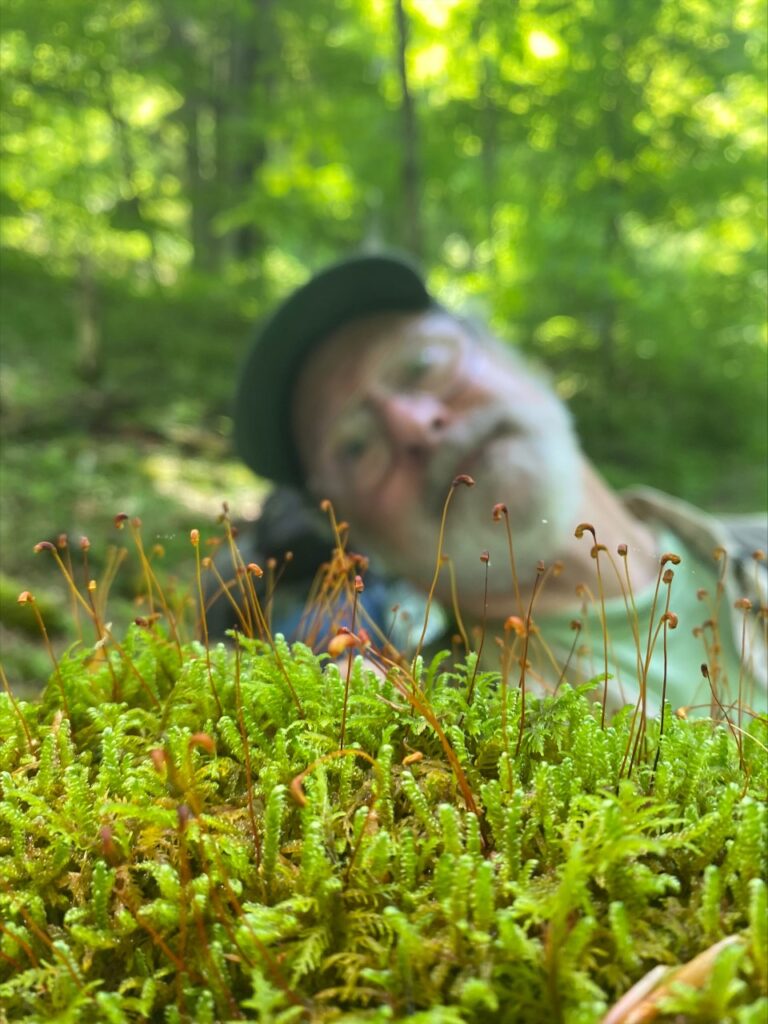Deep Woods, the Appalachian Gametophyte, and Ohio Geobotany
(Hocking Hills, Ohio)
Sandstone Substrate-Associated Plants:
Before we begin looking at sandstone substrate-associated plants, biotic threats to forest life, the Appalachian gametophyte, and a few other observations I want to tell you a little bit about the diversity of southeastern Ohio sandstone substrate. Dr. Klips had us meet at a private piece of land called the Deep Woods Preserve. A family named Blyth owns this and allowed us to hike and explore their land which we are very thankful for.
When we think of sandstone hills in Ohio we can know that the substrate of this sandstone is dry and acidic. When reading the article titled, “Linking Geology and Botany” by Jane L Forsyth she mentions that the tops of hills is where the driest substrate is and quite a few of our characteristic sandstone trees were found here. A few examples mentioned are chestnut oak, sourwood, scrub pine, pitch pine, hemlock, and many many more. In the ravines, the climate is moister and cooler which makes it more suitable for hemlock.
There are many more plants that you could spend all day learning about, but for now let’s focus on the American chestnut, sourwood, eastern hemlock and a blueberry plant! Yum! Keep reading and learn some interesting factoids about these plants with me. Ready, set, go!
-American Chestnut-
Castanea dentata
When looking at the leaves of an American chestnut tree you should look for a tree that has large, but narrow leaves. The leaves are also coarsely toothed Peterson’s field guide mentions that the buds are blunt, few scaled and the twigs are hairless. The American chestnut is commonly mistaken for the compound-leaved Horsechestnut. Most of the time the American chestnut sprouts from old stumps and it does bear fruits that are nuts. When the tree does flower, it flowers around June-August. Believe it or not this tree was once very dominant, but has been a rare find because of a fungal disease that is believed to be of Asiatic origin. Chestnut lumber is generally used for furniture, musical instrument, caskets, and fences. We aren’t the only animals that like them though! Bobwhite, wild turkeys, squirrels, and whitetail deer once fed on the nuts of this tree.
-Sourwood-
Oxydendrum arboreum
According to Petrides field guide the sourwood is the only full-size tree with flowers and fruit clusters of the heath type not to be confided with the candy. it leaves are narrow to egg shaped and have a sour taste hence the name. The twigs on the street are hairless and the birds are small. This tree has dark bark and the bark is furrowed. You can see this tree flowering from June to July. It is hard to confuse this tree with other trees due to the fact that it is the only tall non-evergreen tree with one bundle scar and tooth simple leaves. This tree is highly ornamental at all seasons but especially when it’s flowering. The sweet nectar from the sourwood was used as gum. It also has some medical uses and it was used to treat urinary problems. Dear happened to really like eating the twigs on this tree. (https://caseytrees.org/2012/08/tree-month-sourwood/#:~:text=The%20sweet%20nectar%20and%20sap,dysentery%2C%20and%20many%20other%20symptoms.)
-Eastern Hemlock-
Tsuga canadensis
Peterson’s field guide has a lot to mention when regarding the Eastern Hemlock. The eastern hemlock is frequently a more round top tree than spruces or firs. it’s twigs and branch let’s are more flexible and they are sad to ride with the wind. it’s needles are not very long and they are white and beneath. The twins are rough when the leaves are removed. The eastern hemlock also has cones, bark that is dark, and rough. The delicate silvery foliage and small, pendent, perfectly formed brown cones of the hemlock make this one of the most beautiful forest trees. It is said to be a poor Christmas trees because the leaves fall upon dry. this tree was formally spared the acts because of poor quality of wood and stone like hardness of the knots which will chip steel blades. The lumber was taken for pulp but particularly was useful for railroad ties since it holds spikes exceptionally well. The bark of this tree is rich in tanning and a tea was made from it before. The seeds and needles are eaten by roughed and sharp tailed grouse. The twigs are browsed by deer, red squirrel, snowshoe hare, and cottontail rabbits.
-Lowbush Blueberry-
Vaccinium angustifolium
The early low blueberry is a hairless shrub. The leaves are egg shaped to elliptic and may have a few bristle tipped teeth or teeth maybe lacking. The foliage is dull above, whitish beneath; and may become somewhat leathery with age. This shrub flowers between the months of April and June and it’s fruits are dark blue with white powder. The fruits are sweet. sometimes it is hard to distinguish the low blueberry from the Elliot blueberry and slender blueberry. The lowbush blueberry has narrower thinner leaves with a full set of teeth, the Elliot and slender blueberries have leaves that are shiny above and their fruits are black. Native Americans were first to use blueberries as a natural flavoring similarly as it is used today. The fruits are eaten by a wild turkey, ruffed grouse, and gray fox. Whitetail deer and cottontail browse twigs.
Biotic Threats to Forest Health:
Unfortunately, there are many biotic threats to the forest ecosystem that we explored. Dr. Klips pointed a few of these out which included the American chestnut, the eastern hemlock, and the butternut. These trees have been severely affected by either insects or fungal diseases. Today we will be taking a closer look into what exactly happened with the American chestnut and the butternut. These trees were a staple of the forest ecosystem so it is very unfortunate to watch these trees go, but nonetheless we are working on ways to help these trees make a rebound.
Let’s begin with the American chestnut, Castaneda dentata. The American chestnut was a keystone species and also a way of life for the Appalachian way. The American chestnut was formerly used to make log cabins, furniture, fence posts, and railroad ties. After being harvested it resprouted in 20 years. This tree filtered sun flight and other animals took advantage of this free on a day to day usage.
In 1904 a forester noticed something strange happening to the chestnuts in the Bronx Zoo. Cankers we’re surrounded by strange spotty, yellow-orange patches. Scientists from the US Department of Agriculture later figured out this was due to a fungus that had arrived on ornamental Japanese chestnuts imported as early as 1876. This fungus parasite kills the top portion of the tree and only leaves the roots and when they attempt to grow again they are quickly gone again. The coal industry also did not aid in helping the American chestnut as it wiped out the ecosystem. In the early 2000s the Appalachian Regional Reforestation Initiative worked to restore the area. Several national forests have hosted experimental plantings and only time will tell if the research done will yield the long lost giant of the eastern forests. The competitive ability, blight resistance, and impact of deer browsing are all aspects that researchers are aiming to understand in order to improve this tree. Areas that do contain American chestnut are quarantined and scientists are doing their best to eliminate the fungus. (https://www.sierraclub.org/sierra/2021-2-march-april/feature/demise-and-potential-revival-american-chestnut)
Now onto the Butternut, Juglans cinerea. The butternut is a type of walnut tree that is being threatened by a fungal canker disease due to its susceptible nature. The fungal canker disease is known as the “butter-but canker.” This fungus infects butternut trees through small cracks or wounds on the tree that cause a canker. The tree attempts to fight this infection by creating a chemical compartment around the infected site and growing new tissue, but this fungus can cause multiple cankers. It isn’t known where this fungal came from, but it is assumed it was an introduced disease.
Different programs have tried growing more butternut trees next to infected ones to find seedlings that are resistant or partially resistant. The resistant seedlings can be crossed to form a new generation of trees, but this is a lengthy process. Cutting off infected areas of the tree seems to be reasonable, however this provides more openings for the butter-but canker to creep in. As long as the funding is available and imported woods and plants is properly dealt with perhaps the butternut can be saved. (https://wildlife-species.canada.ca/species-risk-registry/species/speciesDetails_e.cfm?sid=793)
The Appalachian Gametophyte:
Among fern species with long-lived gametophytes one of the most peculiar species is known as the Appalachian gametophyte, scientifically known Vittaria appalachiana. Interestingly enough the Appalachian gametophyte is actually a fern and it is in the Phylum Pteridophyta it is very unique due to the fact that it exist is primarily as a vegetatively reproducing gametophyte. Most other ferns exist in the sporophyte stage of their life cycle. Vittaria appalachiana is one of the three ferns in which mature sporophytes have never been observed. It reproduces asexually via gammae.
Fern gammae is differently sized than spores. These gemmae are quite large in comparison to spores. Typically they’re 0.2-1.0 mm in length and are considered too large for long-distance wind dispersal. There are three possible theories of how gemmae are dispersed. These short distance dispersal methods include wind dispersal, water dispersal, and dispersal by other animal species. According to Kilmer and Young (1995) slugs have aided in bryophyte gemmae dispersal. There is also potential that in an article by Rudolphi (2009) that ants aided in dispersal as well.
The Notion of limited dispersal capability is also supported by the absence of the species in the north of the extent of the glacial maximum beyond which a transplant study has shown they were able to survive. Recently disturbed areas like row cuts and tunnels or other substrates that appear suitable have remained uncolonized. This data suggests that spore dispersal from a fully functioning sporophyte must have been responsible for the current distribution of the Appalachian gametophyte. The truncated range of the species in southern New York likewise indicated that the gametophytes lost their ability to reproduce sometimes before the last ice age.
After reading the “Flora of West Virginia” excerpt and the American Journal of Botany article this species most likely did not have a tropical sporophyte source. In an attempt to further understand the life history Farrar (1990) conducted an allozyme study. This study incorporated multiple loci. Only in Ohio and Alabama there was a high level of diversity in the range of species. It was also ruled out that there was possibly a hybridization that created this gametophyte. This gametophyte we now know reproduces asexually and before glaciation it had a sporophyte that started this process.
Invasives, Mosses, Ferns, and More:
On our trip we discovered a variety of botanical wonders and we found some rather rare plants for example the cow-wheat, round-leaves catchfly, sword moss, and snakeskin liverwort. Not only did we see unique plants we also saw a variety of ferns, mosses, and even some parasitic plants. Here I will present to you some information regarding 4 plants I managed to take pictures of. These plants include cow-wheat, haircap moss, multiflora rose, and last but not least the american cancer-root.
-Cow-Wheat-
Melampyrum lineare
Cow-wheat usually grows 6 to 18 inches tall. It has opposite leaves and the lower leaves are lance-shaped with smooth edges. The upper leaves have few pointed, triangular teeth or small lobes on each side near the base of the leaf. Cow-wheat produces small whitish flowers with a yellow lower lip. The flowers resemble a snake head which usually blooms summer to early August. There haven’t been many reported uses of cow-wheat but an Indian tribe has reportedly used it as an eye medicine. Cow-wheat has a mutual benefit with the Wood Ant. It produces a sugary liquid from its tiny glands below the petal that the ants are attracted to and feed on. The seeds of the plant are very similar in appearance to the cocoons of the ant and are transported back to the nest where they can grow. (https://wildadirondacks.org/adirondack-wildflowers-cow-wheat-melampyrum-lineare.html)
-Haircap moss-
Polytrichum
This moss is very common in habituate that receive adequate moisture. It prefers bogs, forests stream edges, and similar moist, somewhat shaded habitats. These mosses form extensive dense, verdant soft carpets. They are around 1.75-4 inches in height and their stems are usually unbranched. The leaves are usually very, very small. They are long and narrow, erect when dry and curved when wet. In terms of color they are green to brown and resemble miniature aloe vera leaves. Teas used from this species of moss have been consumed to relieve and dissolve gall bladder and kidney stones. While digging around to find about animal interactions with haircap moss specific information was lacking, but in general misses are home to many microscopic invertebrates. (https://florafinder.org/Species/Polytrichum_commune.php)
-Multiflora rose-
Rosa multiflora
Peterson’s field guide was able to help me a great deal when researching about the Multiflora rose. roses are usually prickly or bristly arching shrubs with 3 to 11 leaflets per leaf. They have long leafy stipule‘s attached to lower portions of the Lee stock. Twigs and stems are mostly green or red. Rose fruits are known as hips and are fleshy covering numerous small seeds. Hips provide a source of vitamin C which helps with a healthy diet. The multiflora rose isn’t native to the US and it was first introduced from Japan. It was used by humans for erosion control, as a fence to confine livestock and even grown along highways to reduce the glare of headlights from highway medians. They are eaten by wild animals but mostly incidentally or where preferred foods are lacking. Goats really love multiflora rose. About 80% of this diet can come from multiflora rose.
-American cancer-root-
Conopholis americana
The American cancer-root is a fully parasitic plant that occurs only where it can grow attached to the roots of some species of oak. This plant has no chlorophyll therefore it is not green. The stems can grow from 2 to 8 inches in height and the erect stems have numerous scales like flowers that look a bit like a pine cone. The stems usually occur in the late spring with small individual colors. The fruit is very small and when it is dry it splits open when it is ripe. The american cancer root is edible and has a history of being used a remedy for menopause. Today it is used more for things like headaches or bleeding. The seeds and stalks of the cancer root are consumed by many mammals including the white-tailed deer. I think it is also important to note that the american cancer root does not have any scientific evidence that it prevents cancer.(https://www.fs.fed.us/wildflowers/plant-of-the-week/conopholis_americana.shtml#:~:text=American%20cancer%2Droot%20is%20a,no%20green%20color%20to%20it.)

